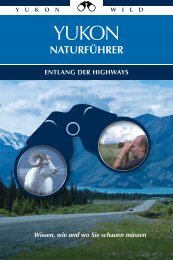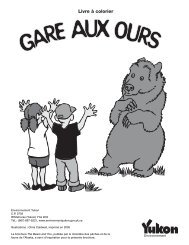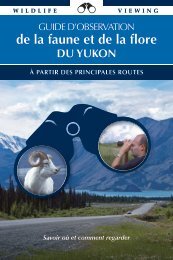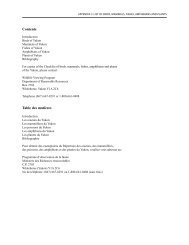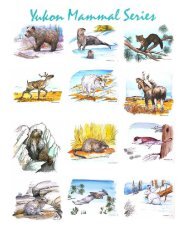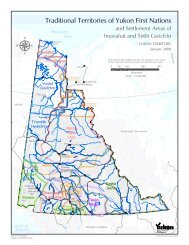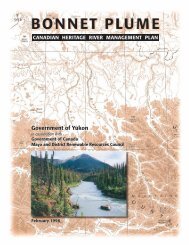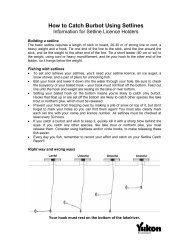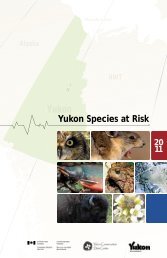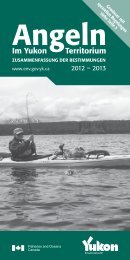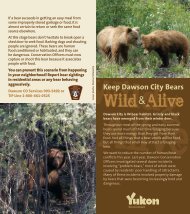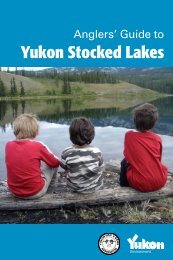Ch. 3 Land - Environment Yukon
Ch. 3 Land - Environment Yukon
Ch. 3 Land - Environment Yukon
You also want an ePaper? Increase the reach of your titles
YUMPU automatically turns print PDFs into web optimized ePapers that Google loves.
This creates uncertainty and delays in<br />
project development and may translate<br />
into higher development costs and<br />
increased potential liabilities to<br />
government.<br />
It would be beneficial to create a<br />
favourable environment to facilitate<br />
finding solutions before environmental<br />
problems in the <strong>Yukon</strong> arise. This<br />
approach was used for the Mine<br />
<strong>Environment</strong> Neutral Drainage (MEND)<br />
program. The MEND program was a<br />
cooperative effort between Canadian<br />
mining companies and provincial and<br />
federal departments. It was designed to<br />
develop and apply new technologies to<br />
prevent and control acid mine drainage.<br />
It is estimated that the liability due to<br />
acidic drainage has decreased by at<br />
least $400 million due to a research<br />
investment of $17.5 million over the<br />
eight year life of the program. The<br />
MEND program was completed in<br />
December 1997; however, in light of its<br />
success, a post-MEND initiative funded<br />
by NRCan and the Mining Association<br />
of Canada emphasizing technology<br />
transfer has commenced.<br />
The Mining <strong>Environment</strong> Research<br />
Group (MERG) is a cooperative<br />
working group of government<br />
agencies, mining companies, <strong>Yukon</strong><br />
First Nations and non-government<br />
organizations for the promotion of<br />
research into mining and<br />
environmental issues in the <strong>Yukon</strong>.<br />
Participants bring their resources and<br />
knowledge to work cooperatively on<br />
mining environmental issues and<br />
projects in an advisory capacity.<br />
PROGRESS &CHALLENGES<br />
Progress since 1995<br />
■ Viceroy Minerals Corporation won<br />
the 1999 Robert E. Leckie Award<br />
for its ongoing reclamation work at<br />
the Brewery Creek gold mine near<br />
Dawson City. In the placer mining<br />
category, Tic Exploration cap-<br />
tured the award for its reclamation<br />
practices on Gladstone Creek.<br />
■ Pamicon Developments Ltd<br />
undertook the clean up of the<br />
Fairchild property at Bonnet<br />
Plume on its own initiative. At the<br />
Copper Point camp, all garbage<br />
was picked up by hand and the<br />
disturbed area was re-seeded.<br />
■ The Mine <strong>Environment</strong> Neutral<br />
Drainage (MEND) Program was<br />
designed to apply new technologies<br />
to prevent and control mine contamination<br />
through mine drainage.<br />
<strong>Ch</strong>allenges<br />
■ Reclamation of abandoned<br />
hardrock mines.<br />
■ Achieving oil and gas development<br />
with minimal environmental<br />
impacts, particularly in the area<br />
of carbon dioxide and sulphur<br />
dioxide emissions.<br />
■ The clean up of contaminants in<br />
old exploration sites and mines<br />
across the <strong>Yukon</strong>.<br />
3.5 Solid Waste<br />
Not so long ago, one main word was<br />
used to describe the items that people<br />
no longer wanted. Everything from old<br />
tires to empty paint cans was called<br />
garbage and chucked into the local<br />
dump. Today we are much more<br />
sophisticated about the subject of<br />
garbage, both in how we define it and<br />
how we handle it.<br />
Solid and special waste are two<br />
classifications that we have for garbage<br />
today. There are strict definitions for<br />
each of these terms, and we have<br />
come a long way in setting regulations<br />
for managing different types of waste.<br />
Unfortunately, we now generate so<br />
much waste, and so many different<br />
types of it, that action to reduce and<br />
manage it is essential.<br />
<strong>Yukon</strong>ers throw out on average almost<br />
two kilograms of trash per day.<br />
This adds up to about 700 kilograms<br />
of waste/person/year. But efforts are<br />
being made at every level to reduce<br />
this amount 1.<br />
There are federal and territorial<br />
objectives to reduce the 1988 volume<br />
of waste by 50 per cent by year 2000.<br />
In 1995, the City of Whitehorse was<br />
diverting 16 per cent of its waste<br />
stream. It has increased that amount to<br />
21 per cent, and started new programs<br />
in 1999 to divert even more waste from<br />
the landfill.<br />
Since the publication of the 1995 State<br />
of the <strong>Environment</strong> Report, several<br />
major initiatives have been introduced<br />
to deal with waste in the territory.<br />
These include:<br />
City of Whitehorse:<br />
■ 1998 Solid Waste Action Plan<br />
<strong>Yukon</strong> government <strong>Environment</strong> Act<br />
Regulations:<br />
■ Beverage Container Regulation<br />
– amended in 1996 and 1998<br />
■ Contaminated Sites Regulations<br />
– January 1997<br />
■ Storage Tanks Regulations<br />
– January 1997<br />
■ Spills Regulations – January 1997<br />
■ Solid Waste Regulations – 2000<br />
All of these initiatives will help both to<br />
reduce waste and manage it more<br />
responsibly. While more progress is still<br />
needed, a brief look at the past shows<br />
how much we have improved already<br />
in some areas.<br />
History of <strong>Yukon</strong> Wastes<br />
Before the Klondike Gold Rush, the<br />
territory did not have a garbage<br />
problem. First Nations had no<br />
dangerous wastes to worry about, and<br />
all of their garbage would have been<br />
organic. The World War Two era is<br />
often seen as the time when garbage,<br />
pollution and special wastes became an<br />
issue in the <strong>Yukon</strong>.<br />
When the Alaska Highway, the Canol<br />
Road and Pipeline, the airports of the<br />
C H A P T E R 3 L A N D ❧ 5 1





